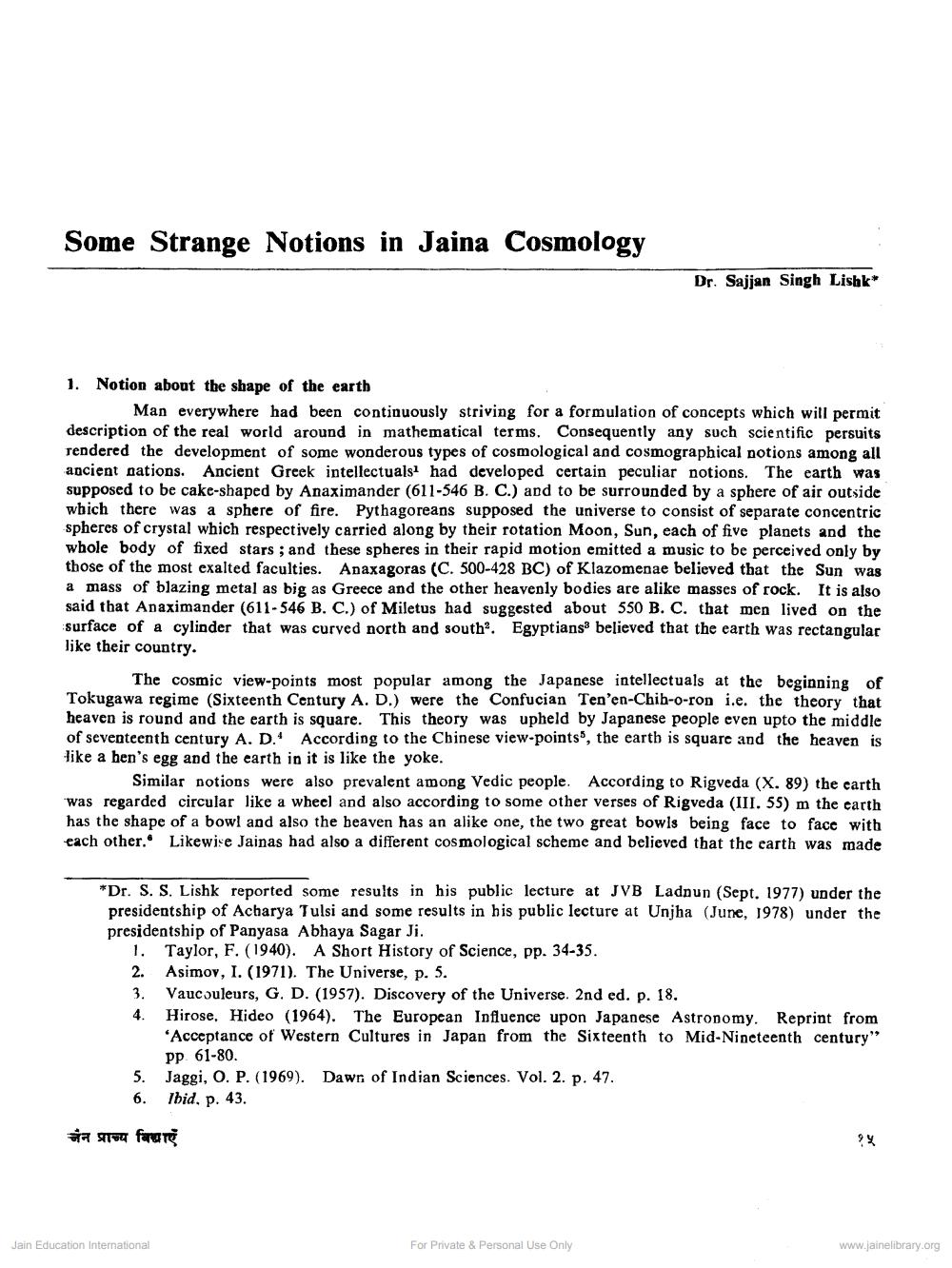________________
Some Strange Notions in Jaina Cosmology
Dr. Sajjan Singh Lishk*
1. Notion about the shape of the earth
Man everywhere had been continuously striving for a formulation of concepts which will permit description of the real world around in mathematical terms. Consequently any such scientific persuits rendered the development of some wonderous types of cosmological and cosmographical notions among all ancient nations. Ancient Greek intellectuals had developed certain peculiar notions. The earth was supposed to be cake-shaped by Anaximander (611-546 B. C.) and to be surrounded by a sphere of air outside wbich there was a sphere of fire. Pythagoreans supposed the universe to consist of separate concentric spheres of crystal which respectively carried along by their rotation Moon, Sun, each of five planets and the whole body of fixed stars; and these spheres in their rapid motion emitted a music to be perceived only by those of the most exalted faculties. Anaxagoras (C. 500-428 BC) of Klazomenae believed that the Sun was a mass of blazing metal as big as Greece and the other heavenly bodies are alike masses of rock. It is also said that Anaximander (611-546 B. C.) of Miletus had suggested about 550 B. C. that men lived on the surface of a cylinder that was curved north and south. Egyptians believed that the earth was rectangular like their country.
The cosmic view-points most popular among the Japanese intellectuals at the beginning of Tokugawa regime (Sixteenth Century A. D.) were the Confucian Ten'en-Chib-o-ron i.e. the theory that heaven is round and the earth is square. This theory was upheld by Japanese people even upto the middle of seventeenth century A. D. According to the Chinese view-points, the earth is square and the heaven is like a hen's egg and the earth in it is like the yoke.
Similar notions were also prevalent among Vedic people. According to Rigveda (X. 89) the earth was regarded circular like a wheel and also according to some other verses of Rigveda (III. 55) m the earth has the shape of a bowl and also the beaven has an alike one, the two great bowls being face to face with each other. Likewise Jainas had also a different cosmological scheme and believed that the earth was made
*Dr. S. S. Lishk reported some results in his public lecture at JVB Ladnun (Sept. 1977) under the presidentship of Acharya Tulsi and some results in his public lecture at Unjha (June, 1978) under the presidentship of Panyasa Abhaya Sagar Ji.
1. Taylor, F. (1940). A Short History of Science, pp. 34-35. 2. Asimov, I. (1971). The Universe, p. 5. 3. Vaucouleurs, G. D. (1957). Discovery of the Universe. 2nd ed. p. 18. 4. Hirose, Hideo (1964). The European Influence upon Japanese Astronomy. Reprint from
“Acceptance of Western Cultures in Japan from the Sixteenth to Mid-Nineteenth century"
pp. 61-80 5. Jaggi, O. P. (1969). Dawn of Indian Sciences. Vol. 2. p. 47. 6. Ibid. p. 43.
जन प्राच्य विद्याएँ
Jain Education International
For Private & Personal Use Only
www.jainelibrary.org




